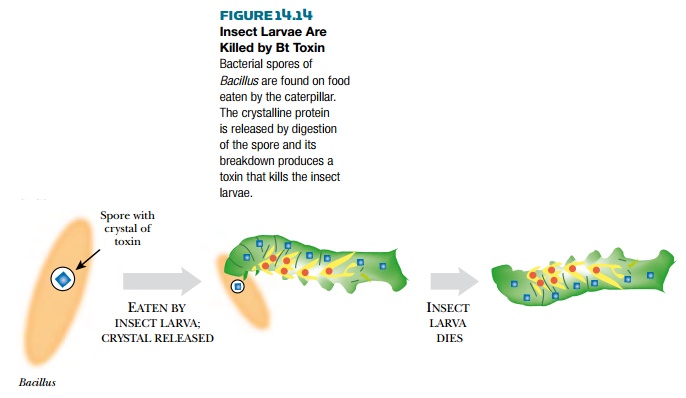Chapter: Biotechnology Applying the Genetic Revolution: Transgenic Plants and Plant Biotechnology
Transgenic Plants with Insect Resistance

TRANSGENIC
PLANTS WITH INSECT RESISTANCE
Although weeds are a
nuisance, even worse enemies of plants, and correspondingly more expensive to
farmers, are:
1.
Insects and roundworms
2.
Fungal diseases (molds, blights, rusts, and rots)
3.
Viral diseases of plants
It is possible to engineer
plants for resistance to all of these, but we will consider just the insects
here. Spraying crops with insecticides is a very costly and hazardous
procedure. Insecticides are often more toxic to humans than are herbicides,
because insecticides target species closer to our own. Many insect biochemical
pathways are found not only in humans, but also in rodents or birds that may
inhabit crop fields. Luckily, naturally occurring toxins exist that are lethal
to insects but harmless to mammals. The prime example is the toxin from a soil
bacterium called Bacillus thuringiensis.
Bt toxin, as it is called, has been
sprayed on crops to prevent insects such as the cotton bollworm and European
corn borer from destroying cotton and corn, respectively. Damage from the
European corn borer plus the cost of insecticides to control it cost farmers
about $1 billion annually. Damage by the corn borer also makes corn plants
susceptible to infection with a toxic fungus that can harm humans if ingested.

Bacteria of the genus Bacillus produce spores that contain a
crystalline or Cry protein. When
insects eat Bacillus spores, the Cry
protein breaks down and releases delta
endotoxin (i.e., the Bt toxin). This toxin binds to the intestinal lining
of the insect and generates holes, which cripple the digestive system, and the
insect dies (Fig. 14.14). Different species of Bacillus produce a family of different but related Cry proteins.
These were originally classified according to insect susceptibility: CryI
killed Lepidoptera (butterflies and
moths), CryII killed both Lepidoptera
and Diptera (flies), CryIII killed Coleoptera (beetles), and CryIV killed Diptera (but not Lepidoptera). However, as the number of known Cry variants
increased, this classification became too simplistic, because sequence
similarities did not always correspond to the spectrum of insecticidal
activity. Cry proteins are now classified with Arabic numerals into some 20
subfamilies based on sequence relationships.
Instead of spraying insects
with the toxin, scientists have used transgenic technology to insert the cry genes directly into plants. When a
cloned toxin gene was inserted into tomato plants, it partly protected against
tobacco hornworm. However, the plants made only low levels of the toxin because
the toxin gene is from a bacterium and is designed to express well in bacteria,
not plants.
Therefore the toxin gene was
altered to enhance expression. The original toxin is a big protein that has
1156 amino acids. However, only the first 650 amino acids are necessary for the
toxic effect; therefore, the protein was truncated by deleting the last half of
the gene. The shorter, truncated protein requires less energy to produce. Next,
the toxin gene was placed under the control of a promoter that gives constant
high-level expression in plants. Certain promoters from plant viruses, such as
cauliflower mosaic virus, satisfy these requirements and give 10-fold increases
in toxin production.
When genes from one organism are expressed in a very different host cell, codon usage also becomes a problem. As explained in Previews Pages, the genetic code is redundant in the sense that several different codons can encode the same amino acid. So although a protein has a fixed amino acid sequence, there is considerable choice in which codons to use. Different organisms favor different codons for the same amino acid and have different levels of the corresponding tRNAs. If a gene uses codons for a rare tRNA, the supply of this may limit the rate of protein synthesis. In practice this is relevant only to genes expressed at high levels—exactly the situation here. Therefore the insect toxin gene was altered by changing many of the bases in the third position of redundant codons. Almost 20% of its bases were altered to make it more plantlike in codon usage. This did not alter the amino acids encoded and, therefore, the toxin protein itself was not affected by this procedure. However, the rate at which plant cells made the protein greatly increased and gave another 10-fold increase in toxin production.
Transgenic Bt crops such as
cotton and corn have many advantages over spraying the fields with the toxin
itself. One advantage is the toxin doesn’t drift over other areas, which
prevents cross-contamination. Using transgenic crops reduces the amount of
insecticide needed. In 1998, about 450,000 kg less insecticide was used on the
U.S. cotton crop alone. Yet only 45% of the cotton crop was actually
transgenic.
Related Topics